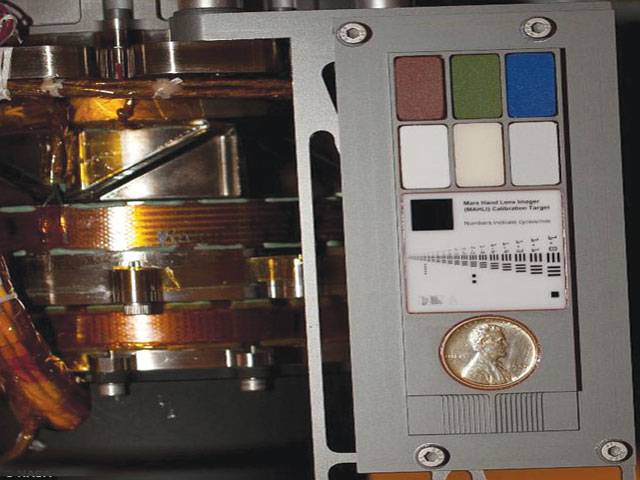THIS amazing picture shows the most valuable penny in the universe - a unique coin which is currently on Mars, helping Nasa's Curiosity rover explore the surface of the red planet.The century-old penny joined the rover on its $2.5billion ride out of the atmosphere, landing on Mars at the beginning of August. But the coin, one of the first batch of Lincoln pennies ever minted, has more than a symbolic value - it is a tool to help scientists calibrate the cameras currently sending an amazing series of images back to Earth.If you calculate the share of the voyage's cost which is attributable to the 2.5-gram penny, it comes out at $7,000, according to Gizmodo. The coin is part of the Mars Hand Lens Imager (MAHLI) camera, pictures of which have recently been beamed back from Mars. Pennies are traditionally used by geologists to provide a sense of scale in their pictures. Even though Curiosity has other, more sophisticated calibrators, NASA has still included the penny in homage to the scientific custom. And this penny is not just any coin - it was minted in 1909, when the Lincoln design was first instituted on the 100th anniversary of the Great Emancipator. The coin is a 'VDB cent', marked with the initials of its designer Victor David Brenner. It was bought for Curiosity by MAHLI engineer Ken Edgett, who personally donated it to the Mars mission.New images taken by Nasa's HiRise spacecraft reveal exactly how far the rover has driven on the red planet. Tyre tracks are clearly visible, as well as the areas where Curiosity landed.Engineers plan to use the images to track Curiosity as it moves across the surface of Mars. Nasa has announced that Curiosity recently completed its longest drive yet, after travelling more than 100 feet on 4 September. Other new images also reveal the final resting places of the comlex kit that brought Curiosity to the surface. The high-tech craft hit the top of the Martian atmosphere at 13,000mph, and was then slowly lowered by a radical floating 'sky crane' before gently arriving in a massive crater. Operators have now photographed the sky crane's final landing site in colour, and also found the parachute and backplate from the landing, which was dubbed 'seven minutes of terror' due to its complexity. –DM
Friday, April 19, 2024
Most valuable penny in universe

Minister reviews naan, roti prices
April 19, 2024
ETPB land worth Rs 40b retrieved so far
April 19, 2024
Lahore revamping plan to complete by June 30
April 19, 2024
CCPO reviews security for by-elections, NZ cricket matches
April 19, 2024
A Tense Neighbourhood
April 19, 2024
Dubai Underwater
April 19, 2024
X Debate Continues
April 19, 2024
Hepatitis Challenge
April 18, 2024
IMF Predictions
April 18, 2024
Kite tragedy
April 19, 2024
Discipline dilemma
April 19, 2024
Urgent plea
April 19, 2024
Justice denied
April 18, 2024
AI dilemmas unveiled
April 18, 2024
ePaper - Nawaiwaqt
Advertisement
Nawaiwaqt Group | Copyright © 2024





